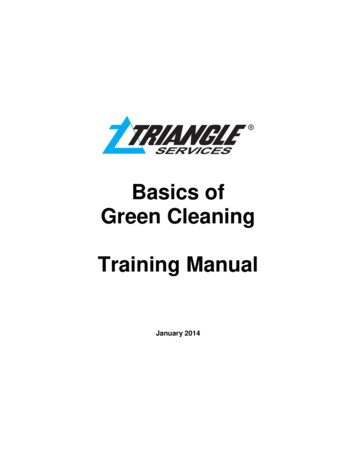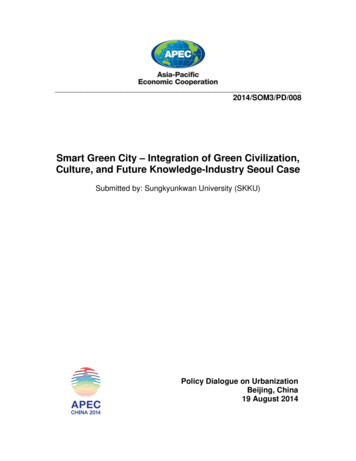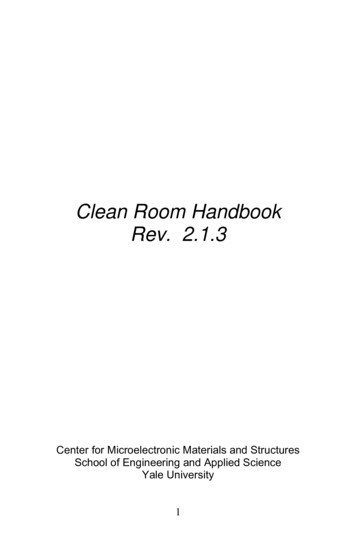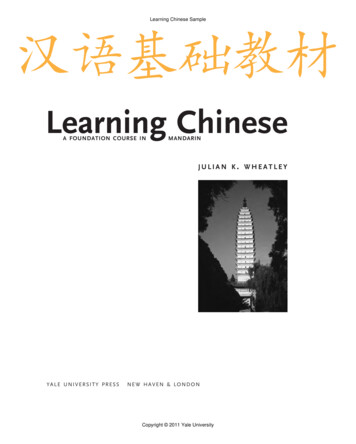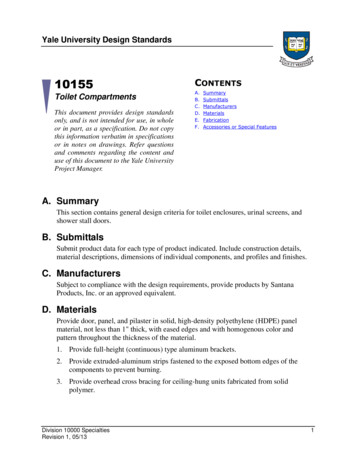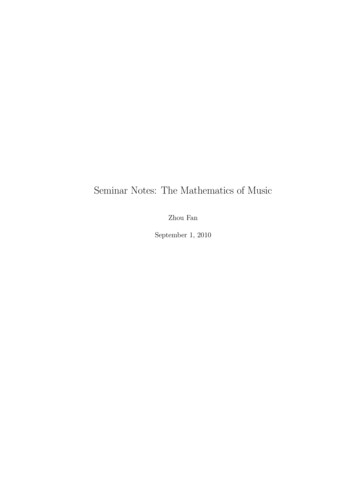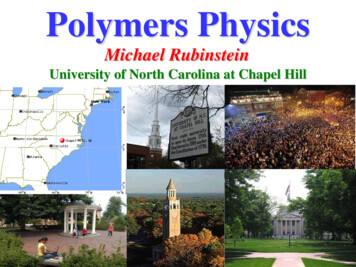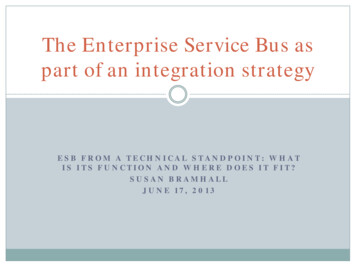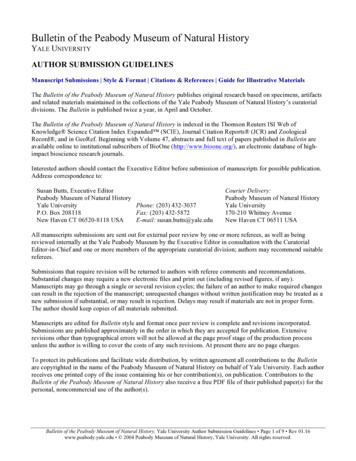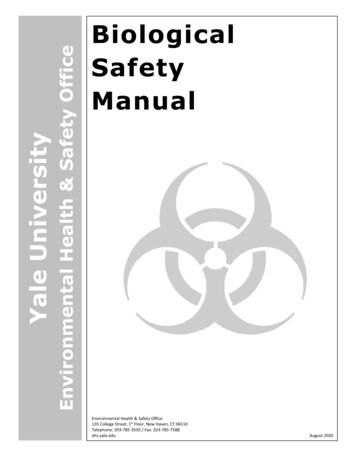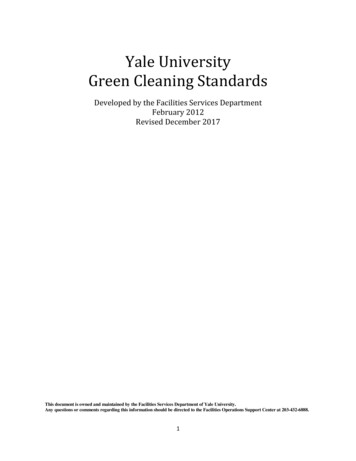
Transcription
Yale UniversityGreen Cleaning StandardsDeveloped by the Facilities Services DepartmentFebruary 2012Revised December 2017This document is owned and maintained by the Facilities Services Department of Yale University.Any questions or comments regarding this information should be directed to the Facilities Operations Support Center at 203-432-6888.1
TABLE OF CONTENTSOBJECTIVE3LEADERSHIP4ADMINISTRATIVE & MANAGEMENT REQUIREMENTSTRAININGVULNERABLE POPULATIONSINSPECTIONSCUSTOMER FEEDBACKPOWERED EQUIPMENT444556STANDARD OPERATING PROCEDURESGENERAL CLEANINGDUST MOPPINGVACUUMINGENTRYWAY MAINTENANCERESILIENT TILE FLOORSNATURAL STONE FLOORS AND RED QUARRY TILE FLOORSCARPET CARE66666777GREEN CLEANING STANDARDSCLEANING EQUIPMENT STANDARDSENTRYWAY SYSTEMSCLEANING PRODUCTSPAPER PRODUCTSLINERSFLOOR CARE SYSTEMSMICROFIBER CLOTHS AND WIPES7881011121313ORBIO TECHNOLOGY14APPENDICESEND NOTES15-17182
ObjectiveThe purpose of this document is to present the framework for the Yale University greencleaning standards and practices. The standards outlined here are intended to reduce theexposure of faculty, staff, students, and visitors to chemical, biological, and particulate matterthat may be harmful to human health, and the built and natural environments.The overall cleaning standards are based on LEED standards. LEED (Leadership in Energy andEnvironmental Design) is an internationally recognized green building certification systemdeveloped by the U.S. Green Building Council (USGBC). Other sources for our standards areGreen Seal (GS) and the Carpet and Rug Institute (CRI) (See Appendix A&E for more details).The LEED rating systems help building owners and operators measure operations,improvements, and maintenance on a consistent scale, with the goal of maximizing operationalefficiency while minimizing environmental impacts. The LEED for Existing Buildings: Operationsand Maintenance program (EBOM) is a certification program that addresses whole-buildingcleaning and maintenance issues (including chemical use), recycling programs, exteriormaintenance programs, and systems upgrades. LEED Building Design and Construction (BD C) isa certification for new or major renovation projects based on their design and construction.Both rating systems award projects for incorporating environmentally responsible and greencleaning practices into building operations and policies.Yale’s cleaning standards are intended to comply with LEED 2009 EBOM Indoor EnvironmentalQuality (IEQ) Prerequisite 3, which has established Green Cleaning Policy requirements forprojects pursuing EBOM or BD C certification. The green chemicals and tools selected underthis standard are for routine cleaning. Where more aggressive cleaning of a non-routine natureis required, chemicals that do not meet this standard may be used. Examples of chemicals inthis latter category are: floor finishes containing metal, strippers containing ammonia, red stainremovers, metal polish, and ceramic tile cleaners.3
LeadershipYale University’s Green Cleaning Standards is a written document establishing how greencleaning standards are to be used, managed, and evaluated. The administration andleadership requirements identified here are for LEED certified buildings or buildingspursuing LEED certification, as well as pertinent to all Yale University buildings. TheUniversity has mandated that all comprehensive new construction and renovation projectdesigns must meet LEED “Gold” status (60-79 points) or Platinum (80 points). LEEDrequirements are based on earning point across several categories, which include energyuse and air quality.Administrative & ManagementRequirementsTrainingA training program has been written for Facilities Superintendents, cleaning and maintenancestaff, who are responsible for implementing green cleaning procedures daily. The trainingprogram is to ensure staff understands the environmental and health issues associated withcleaning products and equipment, as well as their specific responsibilities for application andadherence of the policy. The curriculum covers the hazards, use, maintenance, disposal andrecycling of cleaning chemicals, and dispensing equipment and packaging. The training isconducted annually. All custodians and managers will be trained. Area Managers areresponsible for training program delivery and compliance.Vulnerable PopulationsFacilities Superintendents will provide the Business Manager for each of their buildings a listof the chemicals used in their building. This list is also posted in a prominent place in thebuilding. The list includes instructions on who to notify if any occupants think that any of thechemicals may cause them undue discomfort. Facilities Superintendents will develop a list ofbuilding occupants who self-identify themselves that they may be susceptible to healthproblems from exposure to cleaning and maintenance chemicals. Facilities Superintendentsare responsible for the maintenance of this list for their respective areas. Persons on thevulnerable populations list will be informed prior to any applications of cleaning using nonroutine cleaning chemicals or procedures. To the best of our ability, these individuals will beaccommodated with respect to cleaning procedures via frequencies, timing, product choicesor some combination thereof.4
InspectionsA plan for conducting routine inspections to evaluate the effectiveness of the cleaningprogram, using the Association of Physical Plant Administrators (APPA) standards as a guide, isin place. The University’s target standard is a Level 2. Facilities Superintendents and theirCustodial Team Leaders (CTL) will conduct routine inspections and maintain records ofinspection results and the corrective actions taken. A corrective plan is in place for any areasthat fall below the target level of cleanliness. The plan includes the following: Step OneReview the performance of the custodian to insure procedures are being followed asspecified. This is accomplished by observing the custodian as each task is performed. Thecustodian is retrained in the correct procedures. Step TwoIf procedures are being followed correctly, a review of the process is required. This willinclude a look at the appropriateness of the cleaning tasks and tools, cleaning frequencyand any changes in room usage. For example, if the usage of a room has changed from aprivate office to a staff break room, adjustments in the cleaning tasks and frequenciesmay be required. Step ThreeNew cleaning schedules will be generated that reflect the new cleaning routines. Thecustodian will be retrained in the new procedures. The area will be inspected twice amonth for six months to assure quality levels are maintained.Customer FeedbackYale University staff and employees can request services using the on-line Facilities WorkRequest System (FWR). This system feeds into our Financial Accounts Management InformationSystem (FAMIS). The FAMIS system is the work horse system for all Facilities operations at theUniversity. Customers are selected randomly to comment on the quality of the services theyreceive. Survey results are tabulated every three months, and are forwarded to the managerresponsible for the area. In addition to the FWR system and the FAMIS survey, customers maycall the Customer Service Center 24 hours a day to request, track or provide feedback onservices. All issues are forwarded to the Facilities Superintendent responsible for the building.Facilities Superintendents must establish routine meetings with their building Business5
Managers or other customer representative at least monthly. Facilities Superintendents reportto Area Managers who meet annually with the building Business Manager or customerrepresentative.Powered EquipmentWe are committed to maintaining the use of low-impact powered cleaning equipment andwhen possible plan to upgrade equipment that reduces building contaminants and minimizesenvironmental impacts. For example, equipment that requires less water and chemicals will beused whenever we purchase new or replacement equipment. A log for all powered cleaningequipment has been developed by superintendent, custodial team leader, and/or seniorcustodian. The log documents the date of purchase, manufacturer, model number, serialnumber, and as well as all repair and maintenance activities.Standard Operating ProceduresGeneral CleaningGeneral cleaning of all surfaces is performed per servicing schedule. Microfiber, lint-free cloths are preferred instead of cotton cloths.Dust Mopping and floor CareThe dust mopping of floors and stairwells is performed per servicing schedule. All floors areswept, dust mopped, wet mopped, or auto-scrubbed per servicing schedule. Microfiber flat mop is preferred.VacuumingVacuuming of floors is performed per servicing schedule. Vacuums with HEPA filters are required for vacuums.Entryway MaintenanceEntryway maintenance is performed per servicing schedule.6
Resilient Tile FloorsFacilities Services will continue to test and evaluate more sustainable Green Certified finishes.This will be implemented where practical.Natural Stone Floors and Red Quarry Tile FloorsNatural stone floors and red quarry tile floors are swept, vacuumed or dust mopped, wetmopped or auto scrubbed per servicing schedule. No finish is applied to natural stone floors orred quarry tile floors.Carpet CareCarpets are deep cleaned per servicing schedule using sustainable powered carpet cleaningequipment certified by the Carpet & Rug Institute (CRI). Our machines use less water, fewerchemicals and have advanced ergonomic features compared to non-certified equipment.Interim carpet cleaning is scheduled to address the needs of high traffic areas. Carpets are presprayed before cleaning. Orbio and/or an approved carpet cleaner is an effective pre-spray formost stains. A communication program to educate customers on the handling of small spills,and who to call so that spills can be removed is maintained by Facilities Superintendents.Sustainable flooring which needs less maintenance such as Cork, Nora and Chilewich are typesof flooring being utilized on campus and replacing traditional high maintenance VCT, carpet andother flooring.Green Cleaning StandardsCleaning chemicals should meet one or more of the following standards listed below (see EndNotes for further clarification of Green Seal Standards). Selected chemicals use dilution systemsto minimize waste.Examples include: general-purpose cleaners, bathroom, glass, and carpet cleaners comply withthe Green Seal GS-37 standard.Floor care products comply with the Green Seal GS-40 standard.Paper products and liners comply with the Green Seal GS-01 (toilet tissue paper) standard andGS -09 (paper towels & napkins) standard.Various disinfectants, metal polishers and degreasers comply with the Green Seal GS-40standard and the Canadian Environmental Choice CCD-112, 113, 115, 147 standards.Hand soaps comply with the Green Seal GS-41 standard.Orbio Multi-Surface cleaner meets Green Seal Standard GS-37, and received Platinum Level Sealof Approval from the Carpet and Rug Institute.7
Yale Health Center (YHC) uses different chemicals that have been approved through a separateapproval process.Cleaning Equipment StandardsPowered cleaning equipment that helps to reduce building contaminants and minimize anynegative impact to the built and natural environment is used. Propane-powered equipmentshall not be used.Vacuum cleaners have high filtration systems and/or HEPA systems. These systems have apositive impact on indoor air quality. Yale is using vacuums that meet the Carpet and RugInstitute’s (CRI) Green Label Seal of Approval (See CRI: Appendix B).Carpet extraction equipment, used for restorative deep cleaning is certified by the Carpet andRug Institute’s (CRI) Seal of Approval Testing Program for deep-cleaning extractors.Powered floor maintenance equipment, including electric and battery powered floor buffersand burnishers are equipped with vacuums, guards and/or other devices for capturing fineparticulates.The powered equipment is ergonomically designed to minimize vibration, noise, and user fatigue.The equipment is designed with safeguards, such as rollers or rubber bumpers, to reducepotential damage to building surfaces.Entryway SystemsGrills, grates, and matting are used to reduce the amount of dirt, dust, pollen and otherparticles entering the building at all public entryways. In addition, matting must be in placeimmediately inside all public entryways. Matting should be a minimum length of ten feet. Inlocations where this minimum length is not practical, such as those in stairwells, matting will bepresent if the space physically allows. Entryways that are not in regular use or those that serveas emergency exits are excluded. Entry matting will be cleaned per servicing schedules, which isno less than weekly. Entry matting will have a solid backing to capture water. Matting will beconstructed of low-emitting materials. When possible, matting will contain recycled materials.8
Cleaning ProductsPurposeStandardCurrent ProductMulti-PurposeCleanersYale is using a Neutral PHcleaner, Green Sealcertified multi-purposecleaners or electrolyzedwater.Orbio Multi-Surface CleanerStride DiverseyAlpha HP-DiverseyHand CleanersGlass CleanersHeavy DutyCleaners/DegreasersDisinfectantsYale is using Green Sealcertified non-ammoniatedcleaners or electrolyzedwater for glass as well asstainless steel and chromefixtures.Yale is using a Green Sealcertified or EnvironmentalChoice heavy-dutycleaner/degreasers forroutine buildups of soapand scale in restrooms andshowers.Non-green disinfectantsand disinfectant cleanersare used on a routine basisfor restrooms, lockerrooms, showers withinathletic facilities anddormitories. The OrbioMultiMicro 200disinfectant is used on aregular basis within theuniversity (see list ofbuildings on page 14).9Aero Blue Deb GS-41Glance NA Diversey GS-37Orbio Multi-Surface CleanerCrew 44 DiverseyCrew 42 DiverseyVirex DiverseyClorox FusionClorox Healthcare (only usedduring outbreaks of infectiousdiseases or in YHC)Orbio MultiMicro 200
Paper ProductsOur largest non-labor expense is in paper products. Yale commits to using Green Seal certifiedor EPA preferred towels and tissue that are 100% recycled. The use of post-consumer paperwaste and recovered paper materials can reduce the impact of these materials in landfills andcut down on the use of virgin materials and save trees.PurposeToilet TissuePaper TowelsMulti-fold TowelsStandardYale is using Green Sealcertified or EPA preferredtissues that are 100%recycled.Yale is using Green Sealcertified or EPA preferredtowels that are 100%recycled.Yale has avoided the useof multifold towels, but ifrequired by the location,a Green Seal certifiedproduct has been chosen.10Current ProductEcosoft Bay West GS-01Ecosoft Towels Bay West GS-09Kraft Multifold Bay West GS-09
LinersWe use different-colored liners for recycling where applicable the current Yale standard is bluefor recycling and black or clear for trash. This helps ensure that each type of waste goes into theappropriate container.EBP Item #CasePackDescriptionPC46HRNBrute Barrel - 40 x 46 Natural .59 mil / Dry Load64 lbs.PC24LWNDesk Side - 24 x 24CasePrice250 29.121000 21.47PCSJXHBURecycle Tallboy 28 x 45 Blue .7 mil / Dry Load 64lbs.250 24.86PCSJHRNTall Boy 28 x 45 Natural .59 mil / Dry Load 55 lbs.250 19.60PC58100NHD Brute 38 x 58 Natural .9 mil / Dry Load 94 lbs.150 27.57PC46100NHD Brute Barrel - 40 x 46 Natural .9 mil / Dry Load86 lbs.100 15.4511
Floor Care SystemsZinc-free finishes have been tested and it has been determined that the products currently onthe market are not sufficiently durable in high traffic areas, especially during the wintermonths. We will continue to search for a better alternative, until that time here are our systemsand products:PurposeResilient TileStone FloorsStandardUncertified floor finishesare used on a nonroutine basisUncertified specialtystone care products areused on a non-routinebasisCurrent ProductVectra Diversey - FinishFreedom GS-40 StripperStride Diversey GS 37 - CleanerStride Diversey GS 37 – CleanerCyclone NCL - CleanerPatina NCL - CleanerHurricane NCL – CleanerOrbio Multi-Surface CleanerWood FloorsUncertified specialtywood floor products areused on a non-routinebasisStride Diversey GS 37 - CleanerRestorer Wood Floor- PermaWood- GlowPatina NCL – CleanerOrbio Multi-Surface CleanerMicrofiber Cloths and WipesMicrofiber technology has been evaluated for use in dust mops, wet mops, and wiping cloths.The Department’s goal is that by June 30, 2018 that 98% of all work units in Facilities Serviceswill have microfiber cloths in full use. These will be color coded (red for restrooms, blue forglass and general cleaning). While there will be little to no cost savings, we will be greatlyreducing the amount of waste we produce with cotton cloths that are put into the wastestream.12
Orbio TechnologyA new breakthrough technology — called On-Site Generation (OSG) — is rapidly gaining theacceptance and confidence of early adopters.OSG technology converts water, electricity and a small amount of salt into effective cleaningand antimicrobial solutions. It eliminates the need for many packaged chemicals that have beenused for years to clean education facilities, hospitals, public venues, casinos, retail stores andUsing a combination of just water, salt, and electricity, Orbio technology is a safe, healthy andgreen alternative.The machine uses electrolysis to turn water, salt and electricity into a powerful cleaning agentthat disinfects and sanitizes. The final product is then transferred into either handheld spraycontainers or bigger machines depending on whether it will be used to clean off bathroom andkitchenette counters or floors and carpets.The environment also benefits from Yale’s switching to alternative cleaning products. Orbiotechnology does not have VOCs, dyes, or buffers that can emit harmful chemicals into theatmosphere and water. Since 2013, Yale Facilities have more than doubled their purchases ofgreen-certified chemicals.There is a limitation to Orbio technology. Due to its size, the machine must be placed in alocation where larger groups have access to it. Otherwise, it is not economically feasible. For auniversity campus, however, there are multiple placement opportunities.1Yale University Facilities Using ORBIO SystemSterling Memorial LibraryBass LibraryBeinecke Rare Book Library344 Winchester Ave.Yale Law SchoolYale School of ManagementSage HallKroon HallKBTBassKCLSCLCRBSloane350 EdwardsWatson CenterFounders HallT.M. Evans HallSteinbach Hall46 HillhouseFranklin and Murray13
Appendix AAbout Green SealWe develop life cycle-based sustainabilitystandards for products, services and companiesand offer third-party certification for those thatmeet the criteria in the standard. Green Seal hasbeen actively identifying and promotingsustainability in the marketplace and helpingorganizations to be greener in a real and effectiveway since 1989.Our MissionGreen Seal is a non-profit organization that uses science-based programs to empower consumers, purchasersand companies to create a more sustainable world.Our VisionA Green Economy. One that is as sustainable as possible--renewable, with minimal impact--so that ourenvironment, all forms of life and our natural resources are protected and our social needs and values arehonored.Our HistoryGreen Seal is a pioneer in promoting a sustainable economy. In 1989 there were no other environmentalcertification programs in the US and our founders had the foresight to recognize the need for a tool to helpshoppers find truly green products. They developed the Green Seal as a non-profit to stand for absolute integrity.Over the years the reputation of the Seal brand has grown to symbolize environmental leadership, and it continuesto represent unquestionably green products and services.214
Appendix BBased in D
Rug Institute’s (CRI) Seal of Approval Testing Program for deep-cleaning extractors. Powered floor maintenance equipment, including electric and battery powered floor buffers and burnishers are equipped wit
